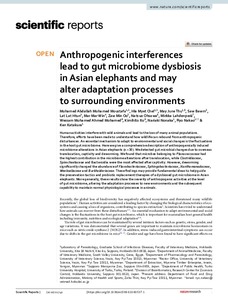Anthropogenic interferences lead to gut microbiome dysbiosis in Asian elephants and may alter adaptation processes to surrounding environments
Moustafa Mohamed Abdallah Mohamed; Chel Hla Myet; Thu May June; Bawm Saw; Htun Lat Lat; Win Mar Mar; Oo Zaw Min; Ohsawa Natsuo; Lahdenperä Mirkka; Mohamed Wessam Mohamed Ahmed; Ito Kimihito; Nonaka Nariaki; Nakao Ryo; Katakura Ken
Anthropogenic interferences lead to gut microbiome dysbiosis in Asian elephants and may alter adaptation processes to surrounding environments
Moustafa Mohamed Abdallah Mohamed
Chel Hla Myet
Thu May June
Bawm Saw
Htun Lat Lat
Win Mar Mar
Oo Zaw Min
Ohsawa Natsuo
Lahdenperä Mirkka
Mohamed Wessam Mohamed Ahmed
Ito Kimihito
Nonaka Nariaki
Nakao Ryo
Katakura Ken
Nature Publishing Group
Julkaisun pysyvä osoite on:
https://urn.fi/URN:NBN:fi-fe2021042821787
https://urn.fi/URN:NBN:fi-fe2021042821787
Tiivistelmä
Human activities interfere with wild animals and lead to the loss of many animal populations. Therefore, efforts have been made to understand how wildlife can rebound from anthropogenic disturbances. An essential mechanism to adapt to environmental and social changes is the fluctuations in the host gut microbiome. Here we give a comprehensive description of anthropogenically induced microbiome alterations in Asian elephants (n = 30). We detected gut microbial changes due to overseas translocation, captivity and deworming. We found that microbes belonging to Planococcaceae had the highest contribution in the microbiome alterations after translocation, while Clostridiaceae, Spirochaetaceae and Bacteroidia were the most affected after captivity. However, deworming significantly changed the abundance of Flavobacteriaceae, Sphingobacteriaceae, Xanthomonadaceae, Weeksellaceae and Burkholderiaceae. These findings may provide fundamental ideas to help guide the preservation tactics and probiotic replacement therapies of a dysbiosed gut microbiome in Asian elephants. More generally, these results show the severity of anthropogenic activities at the level of gut microbiome, altering the adaptation processes to new environments and the subsequent capability to maintain normal physiological processes in animals.
Kokoelmat
- Rinnakkaistallenteet [27094]
